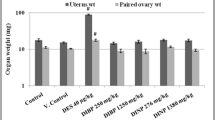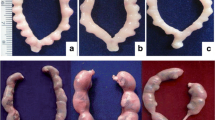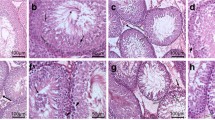Abstract
The study was conducted to assess the effects of in utero di-butyl phthalate (DBP) and butyl benzyl phthalate (BBP) exposure during late gestation on offspring’s development and reproductive system of male rats. Pregnant rats were treated orally with DBP (2, 10, 50 mg/kg), BBP (4, 20, 100 mg/kg), and diethylstilbestrol (DES) 6 μg/kg (positive control) from GD14 to parturition. A significant reduction in dams’ body weight on GD21 in DBP-, BBP-, and DES-treated groups was observed. The gestation length was considerably elevated in the treated groups. Decline in male pups’ body weight was significant at PND75 in DBP- (50 mg/kg), BBP- (20,100 mg/kg), and DES-treated groups. The weight of most of the reproductive organs and sperm quality parameters was impaired significantly in DBP- (50 mg/kg) and BBP- (100 mg/kg) treated groups. Further, a non-significant decline in testicular spermatid count and daily sperm production was also monitored in treated groups. A significant reduction in serum testosterone level in BBP (100 mg/kg), whereas the testicular activity of 17β-HSD was declined non-significantly in the treated groups with respect to control. The data suggests that DBP and BBP exposure during late gestation period might have adverse effects on offspring’s development, spermatogenesis, and steroidogenesis in adult rats.




Similar content being viewed by others
References
Auharek SA, Franca LR, McKinnell C, Jobling MS, Scott HM, Sharpe RM (2010) Prenatal plus postnatal exposure to di (n-butyl) phthalate and/or flutamide markedly reduces final Sertoli cell number in the rat. Endocrinology 151:2868–2875
Clark RL, Antonello JM, Grossman SJ, Wise LD, Anderson C, Bagdon WJ, Prahalada S, MacDonald JS, Robertson RT (1990) External genitalia abnormalities in male rats exposed in utero to finasteride, a 5α-reductase inhibitor. Teratology 42:91–100
Coldham NG, Dave M, Sivapathasundaram S, McDonnell DP, Connor C, Sauer MJ (1997) Evaluation of a recombinant yeast cell estrogen-screening assay. Environ Health Perspect 105:734–742
Dohle GR, Smit M, Weber RF (2003) Androgen and male fertility. World J Urol 21:341–345
Duty SM, Calafat AM, Silva MJ, Brock JW, Ryan L, Chen Z, Overstreet J, Hauser R (2004) The relationship between environmental exposure to phthalates and computer-aided sperm analysis motion parameters. J Androl 25:293–302
Ema M, Miyawaki E (2002) Effects on development of the reproductive system in male offspring of rats given butyl benzyl phthalate during late pregnancy. Reprod Toxicol 16:71–76
Ema M, Miyawaki E, Kawashima K (1998) Reproductive effects of Butyl benzyl phthalate in pregnant and pseudo pregnant rat. Reprod Toxicol 12:127–132
Ema M, Miyawaki E, Kawashima K (2000) Critical period for development of reproductive system in male offspring of rats given di-n-butyl phthalate during late pregnancy. Toxicol Lett 111:271–278
Feuston MH, Bodnar KR, Kerstetter SL, Grink CP, Belcak MJ, Singer EJ (1989) Reproductive toxicity of 2- methoxy ethanol applied dermally to occluded and non-occluded sites in male rats. Toxicol Appl Pharmacol 100:145–161
Giribabu N, Sainath SB, Sreenivasula Reddy P (2012) Prenatal di-n-butyl phthalate exposure alters reproductive functions at adulthood in male rats. Environ Toxicol 1–11. In press.
Gray JR, Ostby J, Furr J, Price M, Veeramachaneni DN, Parks L (2000) Perinatal exposure to the phthalates DEHP, BBP and DINP but not DEP, DMP, or DOTP, alters sexual differentiation of the male rat. Toxicol Sci 58:350–365
Harris CA, Henttu P, Parker MG, Sumpter JP (1997) The estrogenic activity of phthalate esters in vitro. Environ Health Perspect 105:802–811
Hernandez-Diaz S, Mitchell AA, Kelley KE, Calafat AM, Hauser R (2009) Medications as a potential source of exposure to phthalates in the US population. Environ Health Perspect 117:185–189
Hirosawa N, Yano K, Suzuki Y, Sakamoto Y (2006) Endocrine disrupting effect of di-(2-ethylhexyl) phthalate on female rats and proteome analyses of their pituitaries. Proteomics 6:958–971
Howdeshell KL, Wilson VS, Furr J, Lambright CR, Rider CV, Blystone CR, Hotchkiss K, Gray LE (2008) A mixture of five phthalate esters inhibits fetal testicular testosterone production in the Sprague–Dawley rat in a cumulative dose additive manner. Toxicol Sci 105:153–165
Imperato-Mcginley J, Binienda Z, Arthur A, Mininberg DT, Vaughan ED, Quimby FW (1985) The development of a male pseudohermaphroditic rat using an inhibitor of the enzyme 5α-reductase. Endocrinol 116:807–812
Jana K, Jana S, Samanta PK (2006) Effects of chronic exposure to sodium arsenite on hypothalamo-pituitary-testicular activities in adult rats: possible an estrogenic mode of action. Reprod Biol Endocrinol 4:1–13
Jeng HA, Yu L (2008) Alterations in sperm quality and hormone levels by polycyclic aromatic hydrocarbons on airborne particulate. J Environ Sci Health A Tox Hazard Subst Environ Eng 43:675–681
Jobling S, Reynolds T, White R, Parker MG, Sumpter JP (1995) A variety of environmentally persistent chemicals, including some phthalate plasticizers, are weakly estrogenic. Environ Health Perspect 103:582–587
Kim TS, Jung KK, Kim SS, Kang IH, Baek JH, Nam HS, Hong SK, Lee BM, Hong JT, Oh KW, Kim HS, Han SY, Kang TS (2010) Effects of in utero exposure to di (n-butyl) phthalate on development of male reproductive tracts in Sprague–Dawley rats. J Toxicol Environ Health A 73(21–22):1544–1559
Koch HM, Preuss R, Angerer J (2006) Di - (2-ethylhexyl) phthalate (DEHP): human metabolism and internal exposure-an update and latest results. Int J Androl 29:155–165
Kumar S, Patel KG, Gautam AK, Agarwal K, Shah BA, Saiyed HN (1999) Detection of germ cell genetic toxic potential of carbon disulphide using sperm head shape abnormality test. Hum Exp Toxicol 18:731–734
Lehmann KP, Phillips S, Sar M (2004) Dose-dependent alterations in gene expression and testosterone synthesis in the fetal testes of male rats exposed to di (n-butyl) phthalate. Toxicol Sci 81:60–68
Li Y, Zhuang M, Li T, Shi N (2009) Neurobehavioral toxicity study of dibutyl phthalate on rats following in utero and lactational exposure. J Appl Toxicol 29:603–611
Linder RE, Strader LF, McElroy WK (1986) Measurement of epididymal sperm motility as a test variable in the rat. Bull Environ Contam Toxicol 36:317–324
Liu SB, Ma Z, Sun WL, Sun XW, Hong Y, Ma L, Qin C, Stratton HJ, Liu Q, Jiang JT (2012) The role of androgen - induced growth factor (FGF8) on genital tubercle development in a hypospadiac male rat model of prenatal exposure to di-n-butyl phthalate. Toxicology 293:53–58
Lottrup G, Andersson AM, Leffers H, Mortensen Toppari J, Skakkebaek NE, Main M (2006) Possible impact of phthalates on infant reproductive health. Int J Androl 29:172–180
Lyche JL, Gutleb AC, Bergman A, Eriksen GS, Murk AJ, Ropstad E, Saunders M, Skaare JU (2009) Reproductive and developmental toxicity of phthalates. J Toxicol Environ Health B Crit Rev 12:225–249
Mahood IK, Scott HM, Brown R, Hallmark N, Walker M, Sharpe RM (2007) In utero exposure to di (n-butyl) phthalate and testicular dysgenesis: Comparison of fetal and adult end points and their dose sensitivity. Environ Health Perspect 115:55–61
Main KM, Mortensen GK, Kaleva MM, Boisen KA, Damgaard IN, Chellakooty M, Schmidt IM, Suomi AM, Virtanen HE, Petersen DV, Andersson M, Toppari J, Skakkebaek NE (2006) Human breast milk contamination with phthalates and alterations of endogenous reproductive hormones in infants three months of age. Environ Health Perspect 114:270–276
Miguel B, Alicia R, Eduardo C (2006) Effect of two insecticide and two herbicides on the porcine sperm motility patterns using computer-assisted semen analysis (CASA) in vitro. Reprod Toxicol 22:508–512
Mose T, Knudsen LE, Hedegaard M, Mortensen GK (2007) Transplacental transfer of monomethyl phthalate and mono (2-ethylhexyl) phthalate in a human placenta perfusion system. Int J Toxicol 26:221–229
Murono FF, Payne AH (1979) In vivo effect of gonadotropin on steroidogenic enzymes in hypophysectomized immature rats. Biol Reprod 20:911–916
Nagao T, Ohta R, Marumo H, Shindo T, Yoshimura S, Ono H (2000) Effect of butyl benzyl phthalate in Sprague–Dawley rats after gavage administration: a two-generation reproductive study. Reprod Toxicol 14:513–532
Robb GW, Amann RP, Killian GJ (1978) Daily sperm production and epididymal sperm reserves of pubertal and adult rats. J Reprod Fertil 54:103–107
Saillenfait AM, Gallissot F, Sabate JP (2009) Differential developmental toxicities of di-n-hexyl phthalate and dicyclohexyl phthalate administered orally to rats. J Appl Toxicol 29:510–521
Schettler T (2006) Human exposure to phthalates via consumer products. Int J Androl 29:134–139
Sharpe RM, Fisher JS, Millar MM, Jobling S, Sumpter JP (1995) Gestational and lactational exposure of rats to xenoesterogens results in reduced testicular size and sperm production. Environ Health Perspect 103:1136–1143
Silva MJ, Reidy JA, Herbert AR, Preau JL, Needham LL, Calafat AM (2004) Detection of phthalate metabolites in human amniotic fluid. Bull Environ Contam Toxicol 72:1226–1231
Steinberger E (1971) Hormonal control of spermatogenesis. Physiol Rev 51:1–22
Thayer KA, Ruhlen RL, Howdeshell KL, Buchanan DL, Cooke PS, Preziosi D, Welshons WV, Haseman J, Vom Saal FS (2001) Altered prostate growth and daily sperm production in male mice exposed prenatally to sub clinical dose of 17-ethenyl oestradiol. Hum Reprod 16:988–996
Wang YB, Song L, Zhu ZP, Chen JF, Wang XR (2005) Effects of dibutyl phthalate on Sertoli cells of rat testis. Zhonghua Yu Fang Yi Xue Za Zhi 39:179–181
Wyrobek AJ, Gordon LA, Burkhart JG, Francis MW, Jr K, Letz G, Malling HV, Topham JC, Whorton MD (1983) An evaluation of the sperm morphology test and other sperm tests in non-human mammals. Mutat Res 115:1–72
Xiao-feng Z, Nai-qiang Q, Jing Z, Zi L, Yang Z (2009) Di (n-butyl) phthalate inhibits testosterone synthesis through a glucocorticoid-mediated pathway in rats. Int J Toxicol 28:448–456
Zhang Y, Jiang X, Chen B (2004) Reproductive and developmental toxicity in F1 Sprague–Dawley male rats exposed to di-n-butyl phthalate in utero and during lactation and determination of its NOAEL. Reprod Toxicol 18:669–676
Zhu YJ, Jianga JT, Ma L, Zhang J, Hong Y, Liao K, Liu Q, Liu GH (2009) Molecular and toxicologic research in newborn hypospadiac male rats following in utero exposure to di-n-butyl phthalate (DBP). Toxicology 260(1–3):120–125
Acknowledgments
The financial support in the form of a research grant to one of us (SK) received from the Indian Council of Medical Research (ICMR), New Delhi, is thankfully acknowledged. Authors are also thankful to the Ex. Director of the NIOH and the staff of the Animal House Facility and Division of Reproductive and Cytotoxicology for their support during the study.
Author information
Authors and Affiliations
Corresponding author
Additional information
Responsible editor: Philippe Garrigues
Rights and permissions
About this article
Cite this article
Ahmad, R., Gautam, A.K., Verma, Y. et al. Effects of in utero di-butyl phthalate and butyl benzyl phthalate exposure on offspring development and male reproduction of rat. Environ Sci Pollut Res 21, 3156–3165 (2014). https://doi.org/10.1007/s11356-013-2281-x
Received:
Accepted:
Published:
Issue Date:
DOI: https://doi.org/10.1007/s11356-013-2281-x




